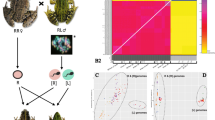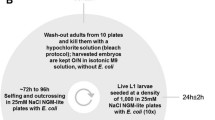Abstract
In many plant and animal taxa mutation rates are higher in males than in females. As a result, the evolutionary speed of genes depends on how much time they spend in either sex. Usually, this time differs between genes located on sex chromosomes but not between those on autosomes. Here we present an unusual system with a partially sex-linked inheritance of autosomes: the hemiclonal frog Rana esculenta (E) which is originally a hybrid between the sexual species R. lessonae (L) and R. ridibunda (R). Rana esculenta excludes the L genome prior to meiosis, produces eggs or sperm containing an unrecombined R genome and restores hybridity by mating with R. lessonae (‘hybridogenesis’). Matings between L males and E females result in offspring with an even sex ratio, whereas the reverse combination produces only daughters. The extent of the resulting female bias and the proportion that R alleles have spent in either sex depend on the relative survival (b) and the relative reproductive contribution (a) of E males vs. E females. In this paper, we analyze mathematically how different combinations of a and b influence the sex ratio in R. esculenta populations and, combined with the male/female mutation rate ratio (α), the evolutionary rate of the clonally transmitted R genome. We find that this rate is higher than in an asexual population and lower than in a sexual one. Hence, clonal diversity through new mutations is more easily achievable than in purely asexual species. In contrast, the occurrence and accumulation of deleterious mutations is lower than in a comparable sexual species. We conclude that these intermediate mutation rates improve the ecological and evolutionary potential of hemiclonal organisms, and we draw attention to the implications for the use of microsatellites.
Similar content being viewed by others
References
G. Abt (2003) Pond use, patterns of reproduction and juvenile recruitment in a mixed waterfrog population University of Zurich Switzerland
G. Abt H.-U. Reyer (1993) ArticleTitleMate choice and fitness in a hybrid frog: Rana esculenta females prefer Rana lessonae males over their own Behav. Ecol. Sociobiol. 32 221–228 Occurrence Handle10.1007/BF00166511
B.R. Anholt H. Hotz G.-D. Guex R.D. Semlitsch (2003) ArticleTitleOverwinter survival of Rana lessonae and its hemiclonal associate R. esculenta. Ecology 84 391–397
H.G. Baker (1965) Characteristics and modes of origin of weeds H.G. Baker G.L. Stebbins (Eds) Genetics of Colonizing Species Academic Press New York 147–172
K. Bergen R.D. Semlitsch H.-U. Reyer (1997) ArticleTitleHybrid female matings are directly related to the availability of Rana lessonae and Rana esculenta males in experimental populations Copeia 1997 275–283
L. Berger (1976) ArticleTitleHybrids of B-2 generations of European water frogs (Rana esculenta complex) Ann. Zool. 33 201–214
L. Berger (1977) Systematics and hybridization in the Rana esculenta complex D.H. Taylor S.I. Guttman (Eds) The Reproductive Biology of Amphibians Plenum Press New York 376–388
L. Berger T. Uzzell (1980) ArticleTitleThe eggs of European water frogs of the Rana esculenta-complex and their hybrids Folio Biol. 28 3–26 Occurrence Handle1:STN:280:Bi%2BB3c3gs1E%3D
L. Berger T. Uzzell H. Hotz (1988) ArticleTitleSex determination and sex ratios in western Palearctic water frogs: XX and XY hybrids in the Pannonian Basin? Proc. Acad. Nat. Sci. Phila. 140 220–239
H.J. Blankenhorn (1977) Reproduction and mating behavior in Rana lessonae–Rana esculenta mixed populations D.H. Taylor S.I. Guttman (Eds) The Reproductive Biology of Amphibians Plenum Press New York 389–410
T.J. Case M.L. Taper (1986) ArticleTitleOn the coexistence and coevolution of asexual and sexual competitors Evolution 40 366–387
B. Charlesworth D. Charlesworth (1997) ArticleTitleRapid fixation of deleterious alleles can be caused by Muller’s ratchet Genet. Res 70 63–73 Occurrence Handle1:STN:280:DyaK1c%2FjsFKjtQ%3D%3D Occurrence Handle9369098
H. Ellegren A.K. Fridolfsson (2003) ArticleTitleSex-specific mutation rates in salmonid fish J. Mol. Evol. 56 458–463 Occurrence Handle10.1007/s00239-002-2416-z Occurrence Handle1:CAS:528:DC%2BD3sXisV2qsbY%3D Occurrence Handle12664165
B. Engeler H.-U. Reyer (2001) ArticleTitleChoosy females and indiscriminate males: mate choice in mixed populations of the water frogs Rana lessonae and Rana esculenta Behav. Ecol. 12 600–606 Occurrence Handle10.1093/beheco/12.5.600
J. Felsenstein (1974) ArticleTitleThe evolutionary advantage of recombination Genetics 78 737–756 Occurrence Handle1:STN:280:CSqD1MvhvVc%3D Occurrence Handle4448362
J.-D. Graf W.P. Müller (1979) ArticleTitleExperimental gynogenesis provides evidence of hybridogenetic reproduction in the Rana esculenta complex Experientia 35 1574–1576 Occurrence Handle1:STN:280:Bi%2BD1M7ptlI%3D Occurrence Handle316396
R. Günther (1990) Die Wasserfrösche Europas Neue Brehm-Bücherei Wittenberg, Germany
G.-D. Guex H. Hotz R.D. Semlitsch (2002) ArticleTitleDeleterious alleles and differential viability in progeny of natural hemiclonal frogs Evolution 56 1036–1044 Occurrence Handle12093017
J.B.S. Haldane (1935) ArticleTitleThe rate of spontaneous mutation of a human gene J. Genet. 31 317–326
J.B.S. Haldane (1947) ArticleTitleThe mutation rate of the gene for haemophilia, and its segregation rates in males and females Ann. Eugenic. 13 262–271
B. Hellriegel H.-U. Reyer (2000) ArticleTitleFactors influencing the composition of mixed populations of a hemiclonal hybrid and its sexual host J. Evol. Biol. 13 906–918 Occurrence Handle10.1046/j.1420-9101.2000.00235.x
A.-K. Holenweg Peter (2001) ArticleTitleSurvival in adults of the water frog Rana lessonae and its hybridogenetic associate Rana esculenta Can. J. Zool. 79 652–661
L.D. Hurst H. Ellegren (1998) ArticleTitleSex biases in the mutation rate Trends Genet. 14 446–452 Occurrence Handle10.1016/S0168-9525(98)01577-7 Occurrence Handle1:CAS:528:DyaK1cXns1ynurg%3D Occurrence Handle9825672
M. Kirkpatrick D.W. Hall (2004) ArticleTitleMale-biased mutation, sex linkage, and the rate of adaptive evolution Evolution 58 437–440 Occurrence Handle15068360
M. Lynch (1984) ArticleTitleDestabilizing hybridization, general-purpose genotypes and geographical parthenogenesis Q. Rev. Biol. 59 257–290 Occurrence Handle10.1086/413902
K.D. Makova W.H. Li (2002) ArticleTitleStrong male driven evolution of DANN sequences in humans and apes Nature 416 624–626 Occurrence Handle10.1038/416624a Occurrence Handle1:CAS:528:DC%2BD38XjtFanurs%3D Occurrence Handle11948348
G. McVean (2000) ArticleTitleEvolutionary genetics: what is driving male mutation? Curr. Biol. 10 R834–R835 Occurrence Handle10.1016/S0960-9822(00)00787-9 Occurrence Handle1:CAS:528:DC%2BD3cXotlGis7g%3D Occurrence Handle11102825
M. Milinski (1994) ArticleTitleHybridogenetic frogs on an evolutionary dead end road Trends Ecol. Evol. 9 62 Occurrence Handle10.1016/0169-5347(94)90270-4
T. Miyata H. Hayashida K. Kuma K. Mitsuyasu T. Yasunaga (1987) ArticleTitleMale-driven molecular evolution: a model and nucleotid sequence analysis Cold Spring Harb. Sym. 52 863–867 Occurrence Handle1:CAS:528:DyaL1cXls1Cgt74%3D
Moeller, A.P. and Cuervo, J.J. (2003) Sexual selection, germline mutation rate and sperm competition. BMC Evol. Biol. 3
H.J. Muller (1964) ArticleTitleThe relation of recombination to mutational advance Mut. Res. 1 2–9
E.D. Parker SuffixJr. R.K. Selander R.O. Hudson L.J. Lester (1977) ArticleTitleGenetic diversity in colonizing parthenogenetic cockroaches Evolution 31 836–842
A.S. Rand M.E. L. Bridarolli Dries M.J. Ryan (1997) ArticleTitleLight levels influence female choice in Tungara frogs: Predation risk assessment? Copeia 1997 447–450
R.J. Redfield (1994) ArticleTitleMale mutation rates and the cost of sex for females Nature 369 145–147 Occurrence Handle10.1038/369145a0 Occurrence Handle1:STN:280:ByuB3s3jsVA%3D Occurrence Handle8177318
H.-U. Reyer G. Frei C. Som (1999) ArticleTitleCryptic female choice: frogs reduce clutch size when amplexed by undesired males P. Roy. Soc. Lond. B 266 2101–2107 Occurrence Handle1:STN:280:DC%2BD3czlvVensg%3D%3D
H.-U. Reyer B. Niederer A. Hettyey (2003) ArticleTitleVariation in fertilisation abilities between hemiclonal hybrid and sexual parental males of sympatric water frogs (Rana lessonae, R. esculenta, R. ridibunda) Behav. Ecol. Sociobiol. 54 274–284 Occurrence Handle10.1007/s00265-003-0635-y
H.-U. Reyer M.-O. Wälti I. Bättig R. Altwegg B. Hellriegel (2004) ArticleTitleLow proportions of reproducing hemiclonal females increase the stability of a sexual parasite-host system (Rana esculenta, R. lessonae) J. Anim. Ecol. 73 1089–1101 Occurrence Handle10.1111/j.0021-8790.2004.00881.x
M. Roesli H.-U. Reyer (2000) ArticleTitleMale vocalization and female choice in the hybridogenetic Rana fessonae/Rana esculenta complex Anim. Behav. 60 745–755 Occurrence Handle10.1006/anbe.2000.1519 Occurrence Handle11124872
B.R. Schmidt (1993) ArticleTitleAre hybridogenetic frogs cyclical parthenogens? Trends Ecol. Evol. 8 271–273 Occurrence Handle10.1016/0169-5347(93)90252-K
R.J. Schultz (1969) ArticleTitleHybridization, unisexuality, and polyploidy in the teleost Poeciliopsis (Poeciliidae) and other vertebrates Am. Nat. 103 605–619 Occurrence Handle10.1086/282629
J.J. Schwartz M.A. Bee S.D. Tanner (2000) ArticleTitleA behavioral and neurobiological study of the responses of gray treefrogs, Hyla versicolor, to the calls of a predator, Rana catesbeiana Herpetologica 56 27–37
R.D. Semlitsch H.-U. Reyer (1992) ArticleTitlePerformance of tadpoles from the hybridogenetic Rana esculenta complex: interactions with pond drying and interspecific competition Evolution 46 665–676
C. Som B.R. Anholt H.-U. Reyer (2000) ArticleTitleThe effect of assortative mating on the coexistence of a hybridogenetic waterfrog and its sexual host Am. Nat. 156 34–46 Occurrence Handle10.1086/303372 Occurrence Handle10824019
H.G. Tunner (1974) ArticleTitleDie klonale Struktur einer Wasserfroschpopulation Z. Zool. Syst. Evol. 12 309–314
T. Uzzell H. Hotz L. Berger (1980) ArticleTitleGenome exclusion in gametogenesis by an interspecific Rana hybrid: evidence from electrophoresis of individual oocytes J. Exp. Zool. 214 251–259 Occurrence Handle10.1002/jez.1402140303
C. Vorburger (2001) ArticleTitleFixation of deleterious mutations in clonal lineages: evidence from hybridogenetic frogs Evolution 55 2319–2332 Occurrence Handle1:STN:280:DC%2BD38%2FmslKgug%3D%3D Occurrence Handle11794790
R.C. Vrijenhoek (1979) ArticleTitleFactors affecting clonal diversity and coexistence Am. Zool. 19 787–797
R.C. Vrijenhoek (1984) Ecological differentiation among clones: the frozen niche variation model K. Wöhrmann V. Löschke (Eds) Population Biology and Evolution Springer-Verlag Berlin, Germany 217–231
A. Zahn (1997) ArticleTitleUntersuchungen zum Rana kl. esculenta – lessonae-Komplex in Oberbayern Salamandra 33 79–88
Author information
Authors and Affiliations
Corresponding author
Additional information
Co-ordinating editor: L. Hurst
Rights and permissions
About this article
Cite this article
Som, C., Reyer, HU. Variation in Sex Ratio and Evolutionary Rate of Hemiclonal Rana esculenta Populations. Evol Ecol 20, 159–172 (2006). https://doi.org/10.1007/s10682-005-5631-4
Received:
Accepted:
Issue Date:
DOI: https://doi.org/10.1007/s10682-005-5631-4




